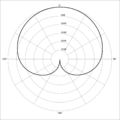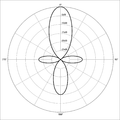Hypercardioid?
-
Kanakattack
- audio school
- Posts: 9
- Joined: Wed Nov 29, 2006 10:53 am
Hypercardioid?
So after a little bit of research, ive heard that hypercariod mics are best for sound isolation on stage - even though they have rear pickup. My question is, why is it better than normal cardioid which has NO rear pickup at all?
well, "better" is a relative term.
Take a look at the plots for a 'typical' cardioid and a 'typical' hypercardioid.

versus

Now take a look at a 'shotgun' pattern as well, just for kicks

Notice that the shotgun mic picks up in both directions across two axes, but the area of pickup is very, very narrow in each of these. It is very short to the sides and very long to the front (on-axis).
If you look at the circumscription of the entire pattern, you will see that a very SMALL percentage of that circle is 'filled' with 'active' areas, even though the pickup lobes sprout off in all directions.
Now go back to the regular cardioid. It has one "null" area, and that is at exactly 180 degrees off-axis. But off-axis sounds don't come from strictly right behind the mic, they come from all around it. A sound that's 120 degrees off-axis will be picked up sure as one that's dead-on. Note that the 'active' area on the cardioid plot takes up over half of the circle.
Now look at our friendly hypercardioid. It has TWO nulls, at about 120 degrees and 240 degrees off-axis. Sounds 180 degrees off-axis will be picked up somewhat, but you have total cancellation of anything 120 or 240 degrees off-axis, with a fairly wide null surrounding either.
If you look at its plot, the overall active portion takes up less of the circumscribed area than the cardioid.
For this reason, cardioid is not always the best choice if you are trying to avoid a 'roomy' sound. A fig 8 mic will often get less 'room' in the sound than a cardioid, because it has two very wide nulls in on the sides.
However, if most what you want to reject is 180 degrees off-axis, then cardioid is the clear winner. But if it's just generic 'ambient sound' you want to reject, then it's not, necessarily.
Hope that helps.
Take a look at the plots for a 'typical' cardioid and a 'typical' hypercardioid.

versus

Now take a look at a 'shotgun' pattern as well, just for kicks

Notice that the shotgun mic picks up in both directions across two axes, but the area of pickup is very, very narrow in each of these. It is very short to the sides and very long to the front (on-axis).
If you look at the circumscription of the entire pattern, you will see that a very SMALL percentage of that circle is 'filled' with 'active' areas, even though the pickup lobes sprout off in all directions.
Now go back to the regular cardioid. It has one "null" area, and that is at exactly 180 degrees off-axis. But off-axis sounds don't come from strictly right behind the mic, they come from all around it. A sound that's 120 degrees off-axis will be picked up sure as one that's dead-on. Note that the 'active' area on the cardioid plot takes up over half of the circle.
Now look at our friendly hypercardioid. It has TWO nulls, at about 120 degrees and 240 degrees off-axis. Sounds 180 degrees off-axis will be picked up somewhat, but you have total cancellation of anything 120 or 240 degrees off-axis, with a fairly wide null surrounding either.
If you look at its plot, the overall active portion takes up less of the circumscribed area than the cardioid.
For this reason, cardioid is not always the best choice if you are trying to avoid a 'roomy' sound. A fig 8 mic will often get less 'room' in the sound than a cardioid, because it has two very wide nulls in on the sides.
However, if most what you want to reject is 180 degrees off-axis, then cardioid is the clear winner. But if it's just generic 'ambient sound' you want to reject, then it's not, necessarily.
Hope that helps.
??????? nicely covered most of it, but I just wanted to add a little about monitor placement for live usage of hypercardioid microphones.
Because hypercardiod mics don't have a null at 180 degrees, you don't want to stick a single monitor directly opposite the singer as you would do with a cardioid microphone. Instead with a hypercardiod you would ideally have two monitors are use the "V" formation that is often seen a larger venues. Thus the signal from the monitors is always highly rejected by the microphone.
Because hypercardiod mics don't have a null at 180 degrees, you don't want to stick a single monitor directly opposite the singer as you would do with a cardioid microphone. Instead with a hypercardiod you would ideally have two monitors are use the "V" formation that is often seen a larger venues. Thus the signal from the monitors is always highly rejected by the microphone.
Last edited by Phiz on Mon Dec 17, 2007 11:59 am, edited 1 time in total.
-
GooberNumber9
- tinnitus
- Posts: 1094
- Joined: Fri Oct 20, 2006 7:52 am
- Location: Washington, DC
One more note about hypercardioids:
Singers who have learned how to "work" an SM58 may have some problems with hypercardioids, because many of them drop off VERY quickly as the singer moves away or to the side. I've seen lots of singers who obviously do a lot of moving around on a 58 to control their sound and levels. As soon as you put an OM7 or e835 in front of them it sounds like there's something wrong because they drop out and in.
I'm not saying don't use hypers. I have found that just telling a singer that the mic will drop off very quickly and they should stay right on it works more than 80% of the time. Some singers will really prefer a 58 and you can really get good feedback rejection on them with a good set of wedges and EQ. I usually save the OM5 for drummers only, cause I hate getting all that extra cymbal bleed in my vocal bus.
Also note that the rear pickup lobe on a hypercardioid is three-dimensional. That means you can put a wedge directly opposite the singer and still hit the null just by pointing the rear of the mic at the audience, instead of at the wedge. You don't have to move the wedge off to the side. By the same token, I've found it helps a bit to put a stand with a 58 on it a little low and point the grill more at the ceiling so the butt is pointed closer to the wedge.
Always keep in mind that pickup patterns are three-dimensional!
Todd Wilcox
Singers who have learned how to "work" an SM58 may have some problems with hypercardioids, because many of them drop off VERY quickly as the singer moves away or to the side. I've seen lots of singers who obviously do a lot of moving around on a 58 to control their sound and levels. As soon as you put an OM7 or e835 in front of them it sounds like there's something wrong because they drop out and in.
I'm not saying don't use hypers. I have found that just telling a singer that the mic will drop off very quickly and they should stay right on it works more than 80% of the time. Some singers will really prefer a 58 and you can really get good feedback rejection on them with a good set of wedges and EQ. I usually save the OM5 for drummers only, cause I hate getting all that extra cymbal bleed in my vocal bus.
Also note that the rear pickup lobe on a hypercardioid is three-dimensional. That means you can put a wedge directly opposite the singer and still hit the null just by pointing the rear of the mic at the audience, instead of at the wedge. You don't have to move the wedge off to the side. By the same token, I've found it helps a bit to put a stand with a 58 on it a little low and point the grill more at the ceiling so the butt is pointed closer to the wedge.
Always keep in mind that pickup patterns are three-dimensional!
Todd Wilcox
- @?,*???&?
- on a wing and a prayer
- Posts: 5804
- Joined: Wed May 07, 2003 4:36 pm
- Location: Just left on the FM dial
- Contact:
Re: Hypercardioid?
Actually, a bit more research would show that a Super-Cardioid yields about 3% to 4% less ambient leakage than a Hyper-cardioid.Kanakattack wrote:So after a little bit of research, ive heard that hypercariod mics are best for sound isolation on stage - even though they have rear pickup. My question is, why is it better than normal cardioid which has NO rear pickup at all?
- JohnDavisNYC
- ghost haunting audio students
- Posts: 3035
- Joined: Fri Oct 03, 2003 2:43 pm
- Location: crooklyn, ny
- Contact:
Who is online
Users browsing this forum: No registered users and 332 guests


